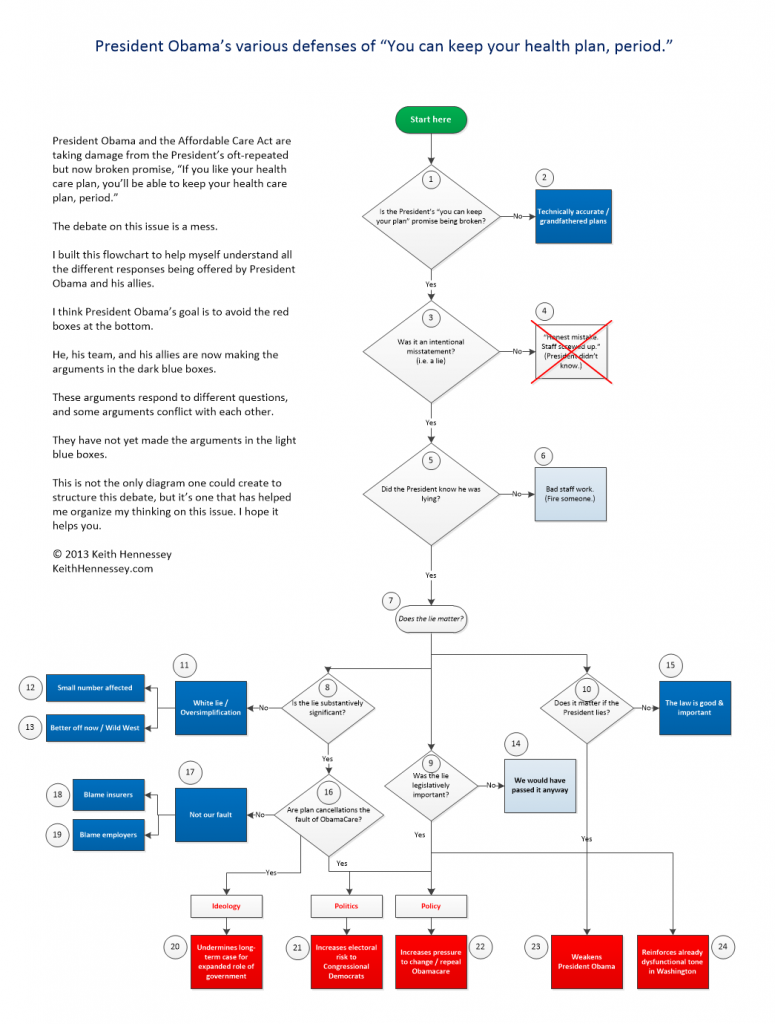UPDATE: I posted this as much for myself as for others to read. Today, Peggy Noonan weighs in. In case this is behind the paywall, here is her conclusion.
Even though it’s huge, and those who are reporting the story every day are, by and large, seasoned and have seen a few things, no one seems to know how it will end. Because it’s new territory. Does anyone believe the whole technological side can be fixed quickly? No. The president may eventually accept a brief delay in implementation—it is almost unbelievable that he will not—but does anyone think that the economics of the ACA, the content as set out and expressed on the sites, will flow smoothly, coherently, and fully satisfy the objectives of expanding health-insurance coverage while lowering its cost? You might believe that, but early reports of sticker shock, high deductibles and cancelled coverage are not promising. Does anyone think the president will back off and delay the program for enough time not only to get the technological side going but seriously improve the economics? No. So we’re not only in the middle of a political disaster, we’re in the middle of a mystery. What happens if this whole thing continues not to work? What do we do then?
This is the Titanic, folks.
I have watched the failed rollout of Obamacare this past three weeks and wondered where it was going. I have some suspicions. There is a lot of talk about delaying the individual mandate, as Obama did with the employer mandate. Megan McArdle has a post on this today. I think it is too late to fix or delay Obamacare.
With Nov. 1 storming toward us and the health insurance exchanges still not working, we face the daunting possibility that people may not be able to sign up for January, or maybe even for 2014. The possibility of a total breakdown — the dreaded insurance death spiral — is heading straight for us. The “wait and see if they can’t get it together” option no longer seems viable; we have to acknowledge that these problems are much more than little glitches, and figure out what to do about them.
She has already described the insurance death spiral. I think it is here.
Am I exaggerating? I know it sounds apocalyptic, but really, I’m not. As Yuval Levin has pointed out, what we’re experiencing now is the worst-case scenario for the insurance markets: It is not impossible to buy insurance, but merely very difficult. If it were impossible, then we could all just agree to move to Plan B. And if it were as easy as everyone expected, well, we’d see if the whole thing worked. But what we have now is a situation where only the extremely persistent can successfully complete an application. And who is likely to be extremely persistent?
Very sick people.
People between 55 and 65, the age band at which insurance is quite expensive. (I was surprised to find out that turning 40 doesn’t increase your premiums that much; the big boosts are in the 50s and 60s.)
Very poor people, who will be shunted to Medicaid (if their state has expanded it) or will probably go without insurance.
Levin points out: It is now increasingly obvious to them that this is simply not how things work, that building a website like this is a matter of exceedingly complex programming and not “design,” and that the problems that plague the federal exchanges (and some state exchanges) are much more severe and fundamental than anything they imagined possible. That doesn’t mean they can’t be fixed, of course, and perhaps even fixed relatively quickly, but it means that at the very least the opening weeks (and quite possibly months) of the Obamacare exchanges will be very different from what either the administration or its critics expected.
The insurance industry is already reacting to Obamacare and this will quickly become irreversible. This article is from September.
IBM, Time Warner, and now Walgreens have made headlines over the past two weeks by announcing that they plan to move retirees (IBM, Time Warner) and current employees (Walgreens) into private health insurance exchanges with defined contributions from employers.
The article calls it “maybe a good thing” but that supposes the exchanges will function. What if they don’t for a year or more ? What will health care look like in November 2014 ?
What happens next — as we’ve seen in states such as New York that have guaranteed issue, no ability to price to the customer’s health, and a generous mandated-benefits package — is that when the price increases hit, some of those who did buy insurance the first year reluctantly decide to drop it. Usually, those are the healthiest people. Which means that the average cost of treatment for the people remaining in the pool rises, because the average person in that pool is now sicker. So premiums go up again . . . until it’s so expensive to buy insurance that almost no one does.
Will that be apparent a year from now ? I’m sure the administration, and the Democrats, will do almost anything to avoid that. What can they do ? They’ve already ignored the law to delay the employer mandates. It’s too late to delay the individual mandate because individual policies are being cancelled right now.
Read more


